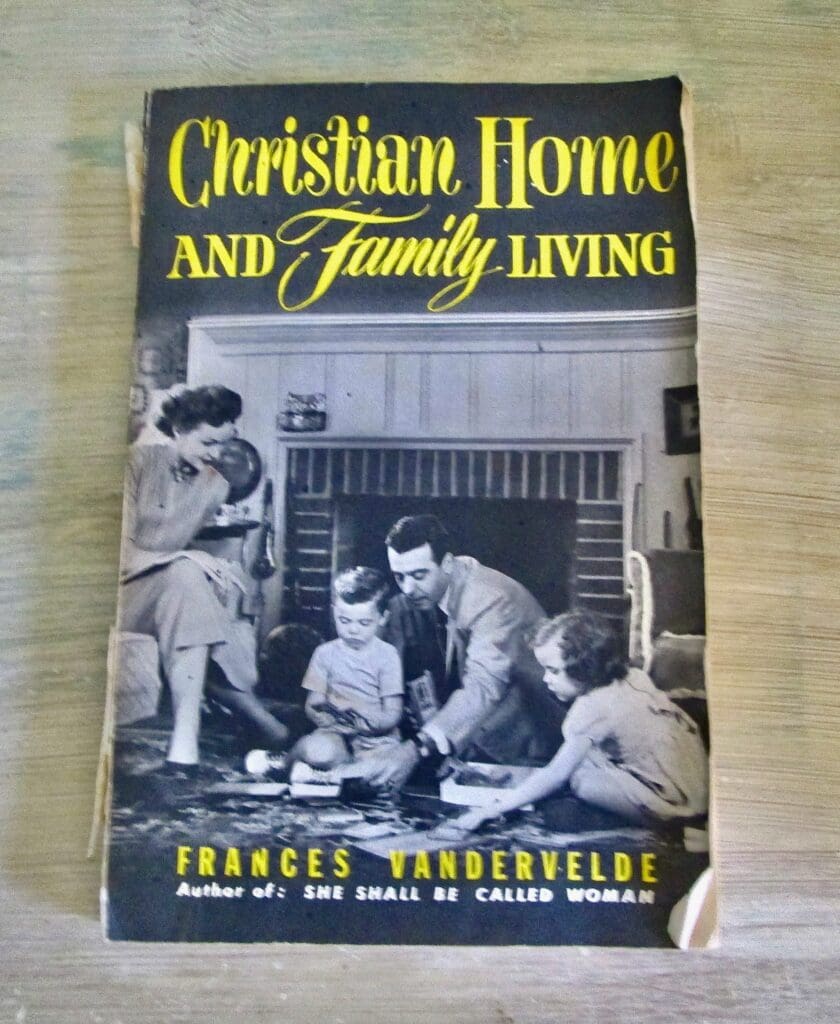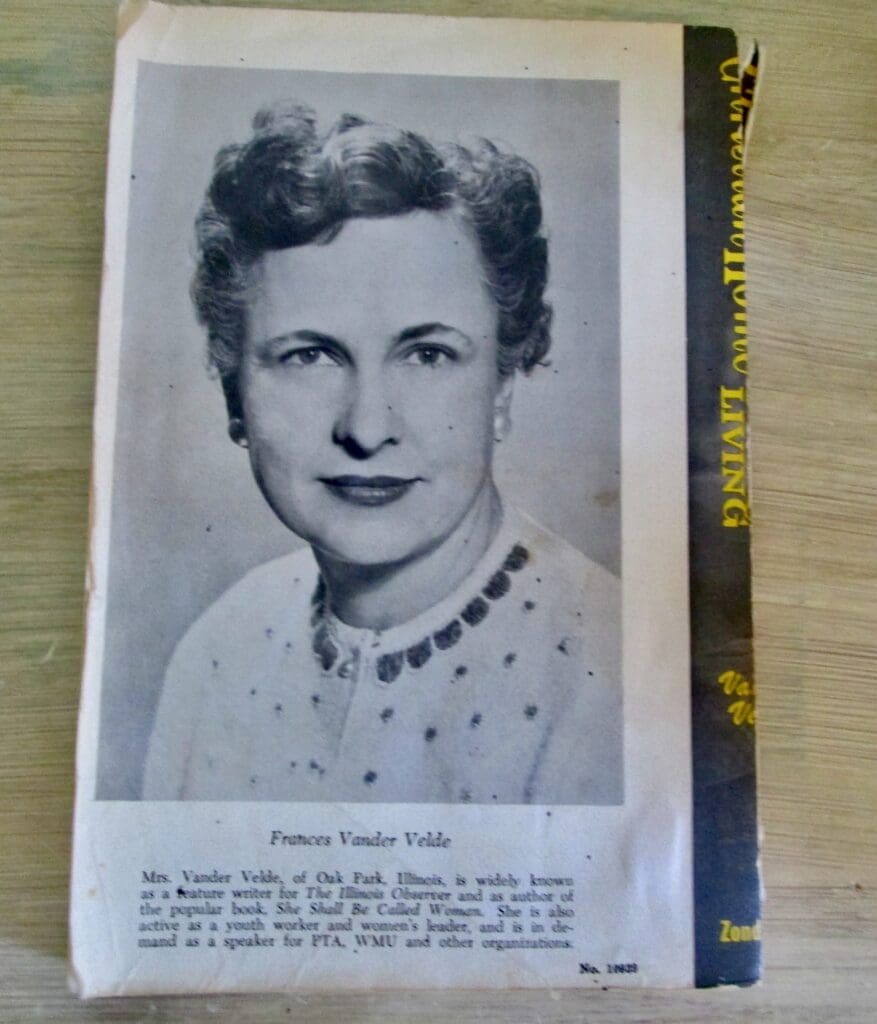During the winter I kept an amaryllis plant in my dining room hoping it would bloom. All of my other amaryllis’ are red. This one, if I remember correctly, is called apple blossom and was a variegated white/pink color.
I finally gave up on it and put it in my small greenhouse around March. When I cleared out my greenhouse for the summer, it was still just foliage, no buds or blooms in sight. I set it out on a small picnic table near the greenhouse and forgot about it.
A few days ago I was watering and checking on some other plants in the area and there it was. It had blown over, was laying on its side for who knows how long without water, and was bone dry.
Yet, it was blooming.

Of course I watered it and brought it inside.

Here’s a closer look, and a lesson to apply to ourselves—sometimes we bloom in the most dire circumstances.
I pulled a book from my shelf yesterday, that I had brought home from my dad’s collection when he was a pastor.
The copyright is 1959, and the title is Christian Home and Family Living, by Frances Vandervelde.
I loved the old fashioned cover.

I’ve always been fascinated by how women of that time period styled their hair, makeup, jewelry, and clothes. Here’s a look at the author on the back cover.

I read through the first two chapters and enjoyed the content very much. I would like to share a few of the ideas from the second chapter titled, The Christian Home.
The chapter begins with a Bible verse:
“Except the Lord build the house they labour in vain that build it.” —Psalm 127:1
The author shares these insights in the first paragraph— “A house in which a family lives is called a home. Homes do not just happen, for given a house a home must still be built. Home is not so much an outward thing to be built, as an inward thing to be created. This is a major undertaking and not understood by all parents today.” (p.16)
She continues, “There are few things which interest us, as Christian women, more keenly than our homes and families. To succeed in family life is our absorbing goal. A father is the householder, but a mother is the homemaker, with the chief task of making a house a home. Hers is the challenge to make home a retreat from the sapping struggle of the workaday world, the place of rest and renewal of body and spirit, a place where all are loved and feel secure, where faith and trust are the atmosphere, and happiness, sadness, cares and achievements are shared.
We are being made increasingly aware, also, that success in vocation, in social and civic spheres, in Christian family living in every way of life depends, in no small way, on how well we fill our places as homemakers and Christian parents.
God made the family to be the basic unit of life (Genesis 1:27,28) and, in every known culture since that day, the family has remained the foundation and axis of society.” (p.16)
Here’s more… “Every good activity and institution was born within its walls. From earliest days the home was the center of worship; the first industrial problems were parleyed there; law and government began with parental authority and discipline; the beginnings of hospitals began with home nursing; the seeds of democracy, education, culture, libraries, social clubs, and character building enterprises found inception in the family. One by one these historic functions found fruition outside of the home. Due to what we can call progress, quite different patterns have emerged, and the family is not the compact unit of former years.” (p.17)
“All the great promises of God are given to the family, and parents are specifically and repeatedly enjoined to train their children on earth that they may be together in heaven…. He (Jesus) restored the dignity of the woman in the home, respected and obeyed His mother, and gladly accepted hospitality and fellowship in the home of friends. He often pointed to the role of a father (Matthew 7:9-11; 21:28 Luke 15:11ff), looked deep into the heart of a mother (John 16:21; Matthew 15:21 ff), and proclaimed to all the worth of a little child (Matthew 18:1-2). (p.18)
The author shares Psalm 128 as a “lovely sketch of such a peaceful, prosperous, happy home.” (p.18)
Frances Vandervelde wrote, “There are homes everywhere, but only one for each of us. God, in His divine wisdom, arranges for the intimate relationship of certain people, in a certain place, for the enrichment of their own lives, for the good and blessing of the larger community in which they live, and for the gathering together of the family of heaven (Acts 2:39). In God’s plan each needs the other: the strong, the young, the old, and the crippled one; each in the interacting of personalities contributes to the development of the other. (p.19)
She also writes, “In a Christian home conflicts and tensions can be resolved before they cause a real rift in family relationships. God’s Word is our guide, and in it we find abundant instructions for harmonious and godly family living. Faith and trust in God must be the atmosphere. Everywhere we read that concern for one’s brother is of paramount importance, and that family love must be rooted in God.” (p. 20)
She gives many Bible references for these statements:
- Exodus 20:1-21
- Proverbs 4:1-4
- Colossians 3:12-17
- 1 Timothy 5:4
- Psalm 37:3-5
- 2 Timothy 2:1-4
- James 1:5-6
- Genesis 4:9-11
- 1 Corinthians 8:11ff
- 1 John 4:7,20,21
I loved her statements about working together. She said, “Bearing each other’s burdens may also mean sharing work. Many a worn and distracted mother has not taught children the dignity and blessing of work. There are household tasks that can be shared by little family members. Neither should children, grown old enough to have a job, treat home like a hotel where one is waited on. No one should be overburdened while others are idle. Love will not allow it (Philippians 2:1-7).” (p.21)
And finally, I will share this from the book. “The child’s first religious education (II Timothy 3:14ff), experience of prayer and worship is in the home. Not to bring our children to Jesus as soon as they walk toward anyone is to wrong them, perhaps irreparably. What better time and place than around the table in family devotions? The wise parents let nothing infringe on that time of precious fellowship which is sanctified by the Word and prayer together.” (21)
Reading this book has given me a longing to go back and correct many things that I would like to have done differently when raising my children and trying to create a loving home. I’m sure many of us have regrets, but if you are a young parent and just starting the building of your home, this book is a great foundation to use to get started. You can actually still find it on Amazon, although the cover is not as interesting.
If, on the other hand, you have not had the best of family circumstances in your life, then take heart from the amaryllis plant. Some of us bloom in the worst of circumstances because no matter what, God is still in control and guiding us, if we allow Him to.
I would like to share a YouTube video on “Christian Homemaking & Building Your Home Economy. The Why.” Kelli, from Home With Kelli, has great insight on how to build your home. I love all of her videos, but this one goes along with Christian Home And Family Living as you look at it from today’s standards. If you work on what Kelli shares, you will have a much better start to building your home. Here is the link. She has a homemaking series and would be a great YouTube Channel to subscribe to if you want to build a stable home.
What are you learning… about how to make your home more Godly? Please share in the comments.
** In the Bible, “ff” is an abbreviation for “and following”. It’s used in footnotes to refer to multiple verses instead of listing them all. When you see it after a Bible reference it means to read the referenced scripture and the verses that come after it.

Beautiful plant. I’m so glad you enjoyed the book.
Thanks, Joni:)